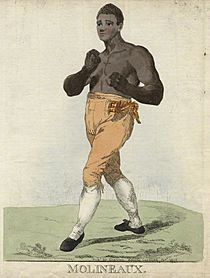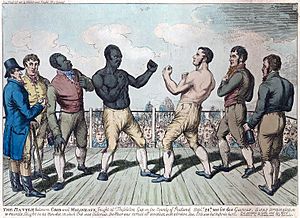Tom Molineaux facts for kids
Quick facts for kids Tom Molineaux |
|
|---|---|

Tom Molineaux by Robert Dighton.
|
|
| Statistics | |
| Rated at | Heavyweight |
| Height | 5 ft 8 in (173 cm) |
| Nationality | American |
| Born | 23 March 1784 Virginia, United States |
| Died | 4 August 1818 (aged 34) Galway, Ireland |
| Stance | Orthodox |
Thomas Molineaux (born March 23, 1784 – died August 4, 1818) was a famous American bare-knuckle boxer. He was also known as Tom Molyneaux. He spent a lot of his boxing career in Great Britain and Ireland.
Tom Molineaux arrived in England in 1809. He started his fighting career there in 1810. He became very famous for his two fights against Tom Cribb. Cribb was known as the Champion of England. Molineaux lost both fights, but he still gained a lot of attention. The first fight was very close and disputed. The second fight was a clear win for Cribb. Molineaux stopped fighting professionally in 1815. He later toured Scotland and Ireland. He passed away in Galway, Ireland, when he was 34 years old.
Contents
Early Life of Tom Molineaux
Tom Molineaux was born in 1784 in Virginia, USA. Some stories say he was born into slavery. He might have gotten his last name from the owners of the plantation where he lived.
One story says he boxed against other enslaved people. This was to entertain the plantation owners. He supposedly won his freedom after winning a big fight. The plantation owner's son had bet a lot of money on him. After becoming free, Molineaux reportedly moved to New York. There, he was said to have won several fights. He even claimed the title "Champion of America." He then moved to England. He hoped to earn money as a prize fighter there.
Boxing Career in Europe
Tom Molineaux arrived in London in 1809. He met Bill Richmond, another former enslaved person who became a boxer. Richmond owned a pub in Leicester Square.
Molineaux's first fight in England was on July 24, 1810. It took place at Tothill Fields, Westminster. He won this fight against Jack Burrows of Bristol. The fight lasted 65 minutes. Bill Richmond helped Molineaux during the fight.
His second fight in England was against Tom Blake. Blake was nicknamed "Tom Tough." This fight happened on August 21, 1810, near Margate. Molineaux won after 8 rounds. Blake was knocked out. People said Molineaux showed great improvement in his boxing skills.
First Fight Against Tom Cribb

On December 3, 1810, Molineaux fought Tom Cribb. Bill Richmond had trained Molineaux for this fight. The match was for the English title. It took place at Shenington Hollow in Oxfordshire.
Molineaux was about five feet eight inches tall. He weighed around 198 pounds for this fight. Many people, including Cribb, thought the fight would end quickly. They expected Cribb to win in the first ten rounds. But Molineaux was a strong and smart fighter. Both boxers hit each other very hard.
There was a problem in the 19th round. Molineaux and Cribb were holding each other. This was allowed by the rules then. The referee was unsure what to do. The crowd pushed into the ring. In the confusion, Molineaux hurt his left hand. It might have been broken. There was also a disagreement about whether Cribb returned to the line in time. If he hadn't, Molineaux would have won. But the fight continued. After the 34th round, Molineaux wanted to stop. But his helper convinced him to keep going. He was defeated in the 35th round.
Two days later, Molineaux received a big cheer in London. He was given 45 guineas (a type of old coin).
Later Fights and Rematch with Cribb
On May 21, 1811, Molineaux fought William Rimmer. Rimmer was a 22-year-old fighter. The fight was at Moulsey Hurst. Molineaux won after 21 rounds.
A second fight with Tom Cribb happened on September 28, 1811. It was at Thistleton Gap in Rutland. About 15,000 people watched this fight. Both fighters weighed less this time. Molineaux weighed about 185 pounds. Cribb had trained very hard for this match. Molineaux still hit Cribb with great power. But Cribb fought better. Cribb broke Molineaux's jaw. He finally knocked him out in the 11th round. After this fight, Molineaux and Bill Richmond stopped working together.
Molineaux had four more fights after this. He won three and lost one. On April 2, 1813, he beat Jack Carter. This fight lasted 25 rounds. After that, Molineaux went on tour. He showed off his boxing skills in exhibition matches. In 1813, he fought Abraham Denton. Denton was described as a very large country boxer. Molineaux won that contest.
His tour took him to Scotland. On May 27, 1814, he fought William Fuller. The fight was stopped after 4 rounds. The local sheriff and police ended it. A rematch was held a few days later. Molineaux won that fight after 2 rounds. On March 11, 1815, Molineaux lost to George Cooper. This was his last professional fight.
Life After Boxing
Tom Molineaux stopped his professional boxing career in 1815. But he continued to show his skills in sparring exhibitions. After visiting Scotland, he toured Ireland. He was reported to be in northern Ireland in 1817.
He became ill with tuberculosis. He passed away without money in Galway, Ireland, on August 4, 1818. He was 34 years old.
In 2018, the Galway City Museum had an exhibition about Molineaux. This marked 200 years since his death. A plaque was also placed in Galway where he died. In 2019, boxer Katie Taylor unveiled a headstone for his previously unmarked grave. It is in St James' graveyard in Galway.
Legacy and Influence
- It was discovered that Molineaux is a direct ancestor of the American hip-hop star LL Cool J. The rapper learned this on a TV show called Finding Your Roots.
- A colored picture of Molineaux by Robert Dighton is kept in the National Portrait Gallery in London.
- A fictional story about Molineaux's boxing life is the book Black Ajax by George MacDonald Fraser.
- Molineaux was featured in a 2003 TV show called Georgian Underworld: Bare Knuckle Boxer.
- He is also in a short animated film called The Prize Fighter.
- The writer Robert E. Howard, who loved boxing, included Tom Molyneaux as a ghost in his short story Apparition in the Prize Ring.
- A play called Prize Fighters was made in 2014. It was based on Molineaux's fight with Cribb.
- Molineaux's 1811 rematch with Cribb is mentioned in the novel Regency Buck by Georgette Heyer.
- Molineaux was added to the International Boxing Hall of Fame in 1997.
- In 2010, Molineaux was also added to the Bare Knuckle Boxing Hall of Fame.
- A documentary film about him, Ag Trasnú an Atlantaigh Dhuibh/ Crossing the Black Atlantic, was shown in 2017.
Images for kids
See also


